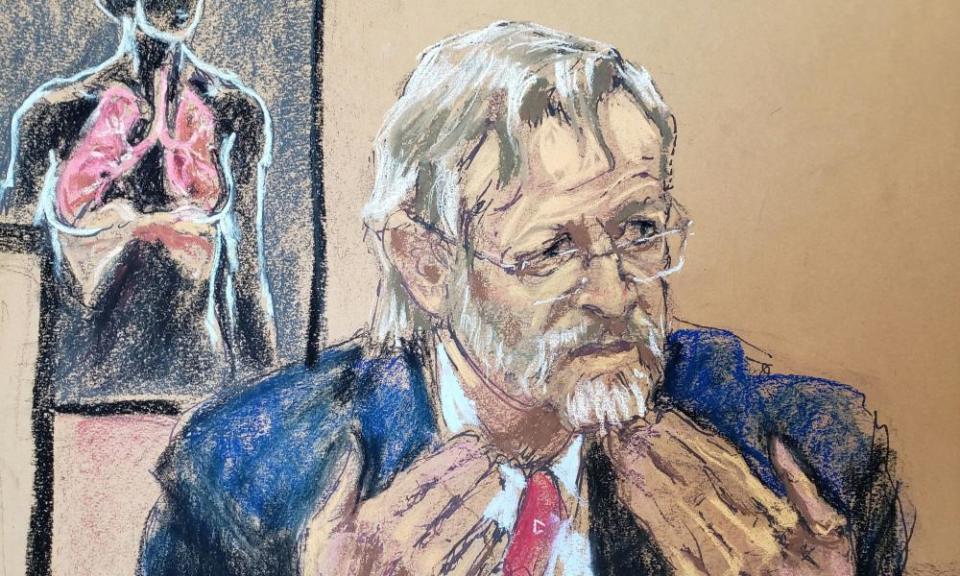George Floyd died from lack of oxygen caused by restraint, lung expert testifies

A leading pulmonary expert has told the Derek Chauvin murder trial that George Floyd was killed by a lack of oxygen because a knee was pressed into his neck while he was held facedown in handcuffs.
As the trial entered its ninth day of testimony, Dr Martin Tobin, a pulmonary and critical care specialist for 40 years, told the jury that the 46-year-old Black man was caught in a “vice” between Chauvin and the street as the breath was squeezed out of him.
Related: Derek Chauvin trial: George Floyd died from ‘low oxygen’, doctor says – live
“Mr Floyd died from a low level of oxygen and this caused damage to his brain,” he said.
Tobin said that in turn caused Floyd’s heart to stop.
Asked about the cause of the oxygen deprivation, Tobin said that Floyd’s breathing became increasingly shallow because of how he was being held on the ground by Chauvin and two other police officers for more than nine minutes.
“He’s turned prone on the street, that he has the handcuffs in place combined with the street, and then that he has a knee on his neck, and that he has a knee on his back,” the doctor said.
Tobin gave graphic testimony about Floyd’s desperate struggle to breathe as the position he was held in meant he could barely use one of his lungs at all.
“It was almost to the effect that if a surgeon had gone in and removed the lung,” he said.
The evidence is central to the prosecution’s attempts to head off defence claims that Floyd died from a drug overdose or heart attack or a combination of the two. Tobin said it “was a very dangerous mantra” for the police officers to interpret Floyd saying more than 20 times “I can’t breathe” as evidence that he was in fact able to do so.
Chauvin, 45, has denied charges of second- and third-degree murder, and manslaughter, over Floyd’s death last May, which prompted mass protests for racial justice across the US and other parts of the world. He faces up to 40 years in prison if convicted of the most serious charge.
The prosecution read Tobin’s impressive list of credentials including authorship of a a textbook on mechanical ventilation, described as “the bible” on the subject by the Lancet medical journal.
Tobin also said a key factor in Floyd’s death was how the officers manipulated the handcuffs. The doctor said that one officer is pushing Floyd’s left hand against his chest while Chauvin’s knee is “really rammed” into his back. All of this was being done as Floyd was being squashed into the hard pavement of the street.
“It’s being pushed in from the street at the bottom and the way the handcuffs are manipulated … totally interfere with central features of how we breathe,” he said.
At the same time, Chauvin was placing a good deal of his bodyweight on to Floyd. The specialist said one picture showed the toe of the officer’s boot off the ground, which meant more than half of his bodyweight was coming directly down on Floyd’s neck.
The specialist likened Floyd’s struggle to survive “to breathing through a drinking straw” but much worse.
Tobin said one of Floyd’s fingers can be seen pushing hard into the street and a knuckle is pressing into a tyre on the squad car. He said the detained man was “literally trying to breath with his fingers and knuckles”.
The doctor told the jury that for nearly five minutes under Chauvin’s knee Floyd is still speaking, which shows “that his oxygen levels were enough to keep his brain alive”.
But after that, there is evidence of brain damage. The doctor said Floyd’s leg can be seen kicking out which is a sign of a myotonic seizure caused by lack of oxygen. Tobin said that when Floyd lost consciousness the level of oxygen in his lungs was well below half the normal amount.
Chauvin’s lawyer, Eric Nelson, put it to the doctor that police officers have nowhere near his level of medical training, and his analysis comes after hours of reviewing information.
Tobin acknowledged that even doctors sometimes fail to recognise breathing problems. Nelson said that is therefore reasonable for police officers to make the same mistake in interpreting the ability to talk as evidence of being able to breathe.
Nelson also pushed the defence contention that illicit drugs – a powerful opioid, fentanyl, and methamphetamine – found in Floyd’s system contributed to his death. But Tobin said that the medical signs in the last minutes of his life were not consistent with his death being caused by drugs.
Earlier, he told the court: “A healthy person subjected to what Mr Floyd was subjected to would have died.”
Dr Daniel Isenschmid, a forensic toxicologist, said that he did not find life-threatening levels of drugs in Floyd’s blood. He told the court that the impact of fentanyl varies depending on tolerance but that he had tested the blood of living people with much higher doses of the drug in their system. He said the amount of methamphetamine in Floyd’s blood was less than 94% of those arrested for driving under the influence of the drug.
Although Tobin’s testimony was often detailed and technical, he appeared to keep the attention of jurors, who often took notes.
At one point, he invited the jury to put their fingers on their necks and feel the area above their Adam’s apple, to understand why the pressure applied by Chauvin’s knee was so dangerous to Floyd’s breathing.
Three other officers involved in Floyd’s death are scheduled to be tried together later this year on charges of aiding and abetting murder and manslaughter.
The trial continues.

 Yahoo Finance
Yahoo Finance 